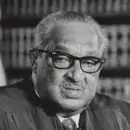
Thurgood Marshall
Thurgood Marshall was a lawyer, civil rights activist, and associate justice of the U.S. Supreme Court (1967–1991). He was the Court’s first African American member. As an attorney, he successfully argued before the Court Brown v. Board of Education of Topeka (1954), which declared racial segregation in American public schools unconstitutional.
He was educated at Lincoln University in Pennsylvania (A.B., 1930) and Howard University’s School of Law (LL.B., 1933). As a protégé of Charles Hamilton Houston, Marshall served as Houston’s right-hand at the NAACP Legal Defense and Educational Fund. Together with Houston, Marshall participated in Murray v. Maryland (1936) and Missouri ex rel Gaines v. Canada (1938). In 1936, Marshall took over as NAACP’s chief legal counsel, and in 1940, he established the NAACP Legal Defense and Educational Fund. In those roles, he argued Sweat v. Painter (1950) and McLaurin v. Oklahoma Board of Regents of Higher Education (1950). Through these cases, he established precedents that gradually dismantled Jim Crow laws in higher education. And with Brown v. Board of Education (1954), Marshall succeeded in having the Supreme Court declare segregated public schools unconstitutional.
In 1961, President John F. Kennedy appointed Marshall to the U.S. Court of Appeals for the Second Circuit. In 1965, President Lyndon Johnson appointed him to the post of Solicitor General. And in 1967, President Johnson appointed him to the U.S. Supreme Court. Until his retirement from the Court in 1991, Marshall worked to protect the rights of all citizens, but found himself increasingly at odds with the ideological shift on the Court that started in the 1970s.